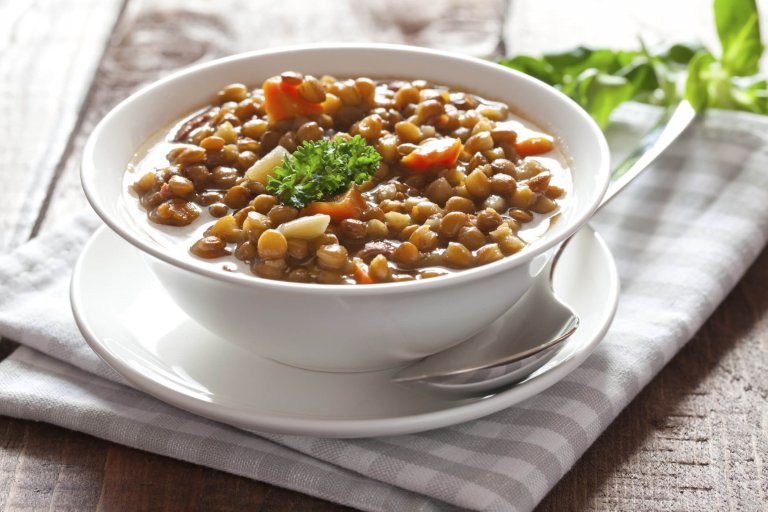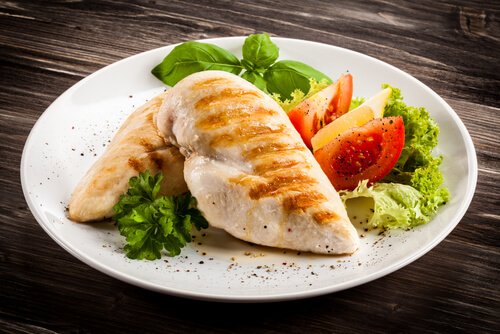What Should a Postpartum Diet Be Like?

After giving birth, you’ll probably want to get your figure back that you had before pregnancy. To do so, you’ll need to think quickly about your postpartum diet. We’ll tell you everything you need to know about it here.
First of all, there is some good news. After delivery, you’ll have lost 12 to 14 pounds.
You might be asking yourself: “How can I have lost that much weight?” Well, 6 to 8 pounds are for the baby, 2 pounds for the placenta, one and a half for the uterus and 2 liters of amniotic fluid.
Foods allowed in the postpartum diet
In this phase of your life, you need foods with lots of vitamins and minerals. Some of these are:
Rich in magnesium
When you’re deficient in magnesium, you’re more likely to feel weak and fatigued. Therefore, some foods rich in magnesium you can eat are: asparagus, sunflower seeds, spinach and nuts.
Folic acid
To keep yourself in good condition, you should include foods with lots of folic acid in your diet. Some of these are beans, broccoli, lettuce, nuts, bananas, oranges, grapes and strawberries.
Foods with iron
Taking iron supplements is common during pregnancy to prevent anemia. After giving birth, you’ll need to replenish your iron supply as well. You’ll need to eat foods with enough iron. Some of these are: red meats, watercress, chard, peas, oats, rice, bread, chickpeas, and lentils.

Calcium
In order to prevent demineralization and produce enough milk, you need to consume enough dairy products. These include milk, non-mature cheese, low-fat yogurt, and creams made with milk.
Postpartum diet menu
To make it easier for you to follow these guidelines, here are two examples of menus:
First menu
- Breakfast: two slices of bread with jam, a glass of skim milk or a serving of cereal with milk.
- Snack: a serving of fruit and two slices of turkey.
- Lunch: fat-free consommé and mashed or baked potatoes. You can also eat a serving of lean meat or fish and a serving of fruit.
- Snack: a cup of fruit salad.
- Dinner: a fruit and portion of chicken with a baked potato or vegetable soup.
Second menu
- Breakfast: a glass of skim milk, a serving of cereal, and orange juice.
- Snack: two slices of wholegrain bread with jam and low-fat yogurt.
- Lunch: a portion of lean meat or fish with a portion of rice or wholegrain pasta. Another option would be a salad with sautéed or regular vegetables with a little olive oil. For dessert, a low-fat yogurt or a serving of fruit.
- Dinner: vegetable soup, or a veggie omelet with chicken or natural tuna. For dessert, either fruit or a low-fat yogurt.
- Before going to bed: a serving of cereal and a glass of skim milk.
“You should include foods with lots of folic acid in your diet. Some of these are beans, broccoli, and lettuce.”
Advice on following a postpartum diet
To make sure this diet is effective, take into account the following tips. Also, make sure to ask your trusted nutritionist if you have any concerns.
- You should include five servings of fruits and vegetables a day in this diet. All these are going to provide your body with vitamins, minerals and antioxidants.
- Distribute the food throughout the day so you have five meals in total: breakfast, snack, lunch, snack and dinner.
- You should not skip meals.
- Drink enough water, approximately 2 liters.
- Consume less sugary products, such as chocolate, sweets, cakes and pastries.
- Avoid sugary sodas.
- Eat all white meats without the skin.

- Incorporate fish into your daily diet. It is full of protein.
- Exercise every day. The most practical thing is to walk. This will help you lose weight and have more energy to take care of your baby.
- Limit foods that are rich in fat, especially ones with saturated fat like red meats and sausages. Also, limit fats added to foods like chips, sauces, butters and oils.
- Consume low-fat dairy products to reduce your fat intake.
- Reduce your sodium intake, like salt or canned and packaged foods.
- Avoid caffeine, alcoholic beverages and carbonated drinks.
- You can take a vitamin and mineral supplement.
In conclusion, the postpartum diet should be healthy and very balanced. When you follow it, you’ll be taking care of both yourself and your baby.
All cited sources were thoroughly reviewed by our team to ensure their quality, reliability, currency, and validity. The bibliography of this article was considered reliable and of academic or scientific accuracy.
- Agencia Española de Seguridad Alimentaria y Nutrición. (AESAN). (25 de mayo de 2023). Mercurio. https://www.aesan.gob.es/AECOSAN/web/seguridad_alimentaria/ampliacion/mercurio.htm
- Better Health Chanel. Breastfeeding and your diet. Abril 2022. Victoria State Government. https://www.betterhealth.vic.gov.au/health/healthyliving/breastfeeding-and-your-diet#how-to-get-your-daily-nutrient-requirements
- National Institutes of Health. Office of Dietary Supplements. (24 de marzo de 2020). Magnesio. https://ods.od.nih.gov/factsheets/Magnesium-DatosEnEspanol/
- Opie, R. S., Uldrich H. C., & Ball, K. (2020). Maternal postpartum diet and postpartum depression: a systematic review. Maternal and Child Health Journal, 24(8), 966-978. https://pubmed.ncbi.nlm.nih.gov/32367245/
This text is provided for informational purposes only and does not replace consultation with a professional. If in doubt, consult your specialist.








